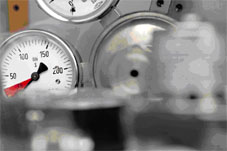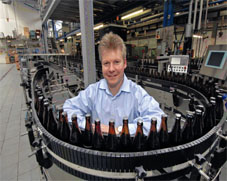
GASKETS, seals and rough pipe surfaces are potential bacteria havens and hygienic challenges for the food and processing industry. The solution? Hygienic design. J黵gen Hofmann unlocks a glass cabinet. "Look at this," he says, pointing to a length of stainless steel piping, which has a short branch at ninety degrees with a bolted-on cover. "There used to be a sensor in here or a similar device, but it was removed and the tube was blocked off. This means that cleaning liquid cannot enter this dead end and the finish here is so coarse that it is easier for the bacteria to adhere to the surface." This is what Hofmann is working to solve. Cleanability is his watchword. He wants the design of machines involved in hygiene-critical operations to facilitate easy and efficient cleaning. For the past nine years, Hoffman has been teaching as an academic assistant with the Department of Process Engineering at the Technical University of Munich's Weihenstephan campus, which specializes in all food-related matters. One of the experts involved in a project run by the Fraunhofer Institute for Process Engineering and Packaging in Germany, he is about to take over the project that comprises an Internet portal called hygienicprocessing.com, which will be a complete information source with regard to hygienic design, with tips, links, a database of literature and a network of experts.

"Hygienic design is relevant in all areas where it is important to keep equipment clean. This includes pharmaceuticals and cosmetics, and even paint," he says.
Reducing 'dead' areas In a way, the aim is simple ?cleaning is carried out with liquids. These must be able to flow smoothly through all the piping, valves, taps and pumps of a machine. Hofmann's job is to ensure that there are no gaps, holes, grooves or "dead areas" that the liquid cannot reach. This requires smooth surfaces, curves that direct liquids in the right direction, and seals and gaskets that fit perfectly. "In the milk industry, it was standard for seals to be set back from the inner surface of the pipes. This created a gap where microorganisms could flourish. The problem is that much effort is needed to clean this kind of equipment. For example, it is necessary to leave cleaning liquids in the pipes for a long time. Such pipes are still used today, but we have helped to design a version where the seal and the inner surface are flush," explains Hofmann. However, according to Hofmann, it is too often the case that investment decisions are made separately. "There is one budget for investment, and another for maintenance, but you can probably save between 25 and 50 percent over the lifetime of the equipment by using hygienic design - particularly if there is a case of contamination, which can involve colossal costs." Not all food products are equally sensitive. For example, beer is less critical than dairy products, because alcohol kills pathogenic bacteria (which makes alcohol-free beer a bigger challenge). The contamination that may be found in beer makes it taste bad, but it is not life threatening. In dairy products, contamination can be more serious and cleaning is crucial. Moreover, some food trends, such as the move away from artificial preservatives, have made hygiene increasingly important.
Cleanability tests For Hofmann, it does not matter what the machinery is processing, the cleaning substance must enter all areas and do its job. The university has a testing center that conducts a cleanability test developed for the European Hygienic Engineering & Design Group (EHEDG). Trelleborg is a sponsoring member of this association. The center runs a standardized contaminant through the part to be tested and through a reference pipe. A standardized cleaning process is subsequently performed using 1-percent alkaline detergent. Following this
Off White X Max 90 GASKETS, seals and rough pipe surfaces are potential bacteria havens and hygienic challenges for the food and processing industry. The solution? Hygienic design. J黵gen Hofmann unlocks a glass cabinet. "Look at this," he says, pointing to a length of stainless steel piping, which has a short branch at ninety degrees with a bolted-on cover. "There used to be a sensor in here or a similar device, but it was removed and the tube was blocked off. This means that cleaning liquid cannot enter this dead end and the finish here is so coarse that it is easier for the bacteria to adhere to the surface." This is what Hofmann is working to solve. Cleanability is his watchword. He wants the design of machines involved in hygiene-critical operations to facilitate easy and efficient cleaning. For the past nine years, Hoffman has been teaching as an academic assistant with the Department of Process Engineering at the Technical University of Munich's Weihenstephan campus, which specializes in all food-related matters. One of the experts involved in a project run by the Fraunhofer Institute for Process Engineering and Packaging in Germany, he is about to take over the project that comprises an Internet portal called hygienicprocessing.com, which will be a complete information source with regard to hygienic design, with tips, links, a database of literature and a network of experts.
GASKETS, seals and rough pipe surfaces are potential bacteria havens and hygienic challenges for the food and processing industry. The solution? Hygienic design. J黵gen Hofmann unlocks a glass cabinet. "Look at this," he says, pointing to a length of stainless steel piping, which has a short branch at ninety degrees with a bolted-on cover. "There used to be a sensor in here or a similar device, but it was removed and the tube was blocked off. This means that cleaning liquid cannot enter this dead end and the finish here is so coarse that it is easier for the bacteria to adhere to the surface." This is what Hofmann is working to solve. Cleanability is his watchword. He wants the design of machines involved in hygiene-critical operations to facilitate easy and efficient cleaning. For the past nine years, Hoffman has been teaching as an academic assistant with the Department of Process Engineering at the Technical University of Munich's Weihenstephan campus, which specializes in all food-related matters. One of the experts involved in a project run by the Fraunhofer Institute for Process Engineering and Packaging in Germany, he is about to take over the project that comprises an Internet portal called hygienicprocessing.com, which will be a complete information source with regard to hygienic design, with tips, links, a database of literature and a network of experts.  "Hygienic design is relevant in all areas where it is important to keep equipment clean. This includes pharmaceuticals and cosmetics, and even paint," he says. Reducing 'dead' areas In a way, the aim is simple ?cleaning is carried out with liquids. These must be able to flow smoothly through all the piping, valves, taps and pumps of a machine. Hofmann's job is to ensure that there are no gaps, holes, grooves or "dead areas" that the liquid cannot reach. This requires smooth surfaces, curves that direct liquids in the right direction, and seals and gaskets that fit perfectly. "In the milk industry, it was standard for seals to be set back from the inner surface of the pipes. This created a gap where microorganisms could flourish. The problem is that much effort is needed to clean this kind of equipment. For example, it is necessary to leave cleaning liquids in the pipes for a long time. Such pipes are still used today, but we have helped to design a version where the seal and the inner surface are flush," explains Hofmann. However, according to Hofmann, it is too often the case that investment decisions are made separately. "There is one budget for investment, and another for maintenance, but you can probably save between 25 and 50 percent over the lifetime of the equipment by using hygienic design - particularly if there is a case of contamination, which can involve colossal costs." Not all food products are equally sensitive. For example, beer is less critical than dairy products, because alcohol kills pathogenic bacteria (which makes alcohol-free beer a bigger challenge). The contamination that may be found in beer makes it taste bad, but it is not life threatening. In dairy products, contamination can be more serious and cleaning is crucial. Moreover, some food trends, such as the move away from artificial preservatives, have made hygiene increasingly important. Cleanability tests For Hofmann, it does not matter what the machinery is processing, the cleaning substance must enter all areas and do its job. The university has a testing center that conducts a cleanability test developed for the European Hygienic Engineering & Design Group (EHEDG). Trelleborg is a sponsoring member of this association. The center runs a standardized contaminant through the part to be tested and through a reference pipe. A standardized cleaning process is subsequently performed using 1-percent alkaline detergent. Following thisOff White X Max 90
"Hygienic design is relevant in all areas where it is important to keep equipment clean. This includes pharmaceuticals and cosmetics, and even paint," he says. Reducing 'dead' areas In a way, the aim is simple ?cleaning is carried out with liquids. These must be able to flow smoothly through all the piping, valves, taps and pumps of a machine. Hofmann's job is to ensure that there are no gaps, holes, grooves or "dead areas" that the liquid cannot reach. This requires smooth surfaces, curves that direct liquids in the right direction, and seals and gaskets that fit perfectly. "In the milk industry, it was standard for seals to be set back from the inner surface of the pipes. This created a gap where microorganisms could flourish. The problem is that much effort is needed to clean this kind of equipment. For example, it is necessary to leave cleaning liquids in the pipes for a long time. Such pipes are still used today, but we have helped to design a version where the seal and the inner surface are flush," explains Hofmann. However, according to Hofmann, it is too often the case that investment decisions are made separately. "There is one budget for investment, and another for maintenance, but you can probably save between 25 and 50 percent over the lifetime of the equipment by using hygienic design - particularly if there is a case of contamination, which can involve colossal costs." Not all food products are equally sensitive. For example, beer is less critical than dairy products, because alcohol kills pathogenic bacteria (which makes alcohol-free beer a bigger challenge). The contamination that may be found in beer makes it taste bad, but it is not life threatening. In dairy products, contamination can be more serious and cleaning is crucial. Moreover, some food trends, such as the move away from artificial preservatives, have made hygiene increasingly important. Cleanability tests For Hofmann, it does not matter what the machinery is processing, the cleaning substance must enter all areas and do its job. The university has a testing center that conducts a cleanability test developed for the European Hygienic Engineering & Design Group (EHEDG). Trelleborg is a sponsoring member of this association. The center runs a standardized contaminant through the part to be tested and through a reference pipe. A standardized cleaning process is subsequently performed using 1-percent alkaline detergent. Following thisOff White X Max 90













